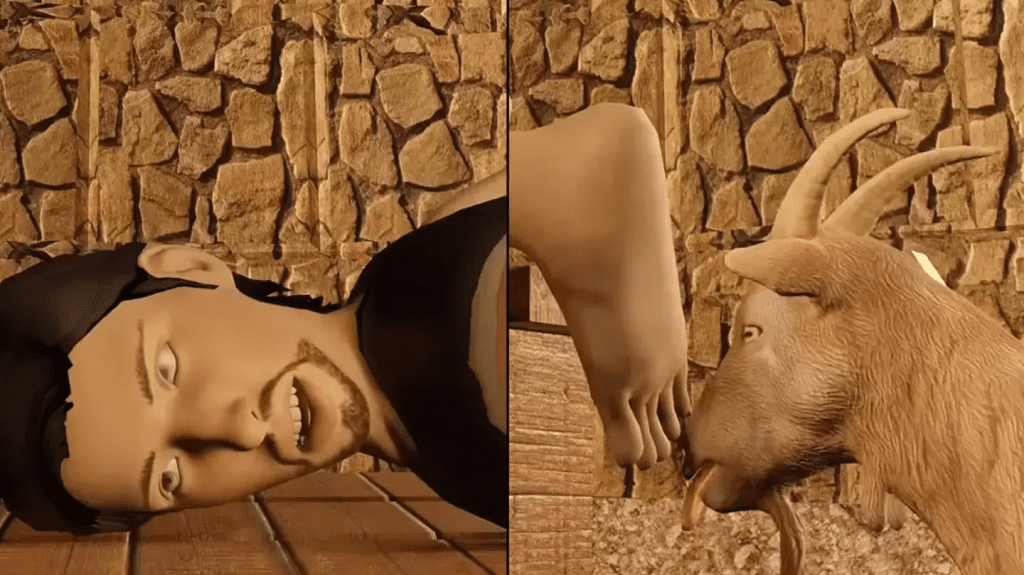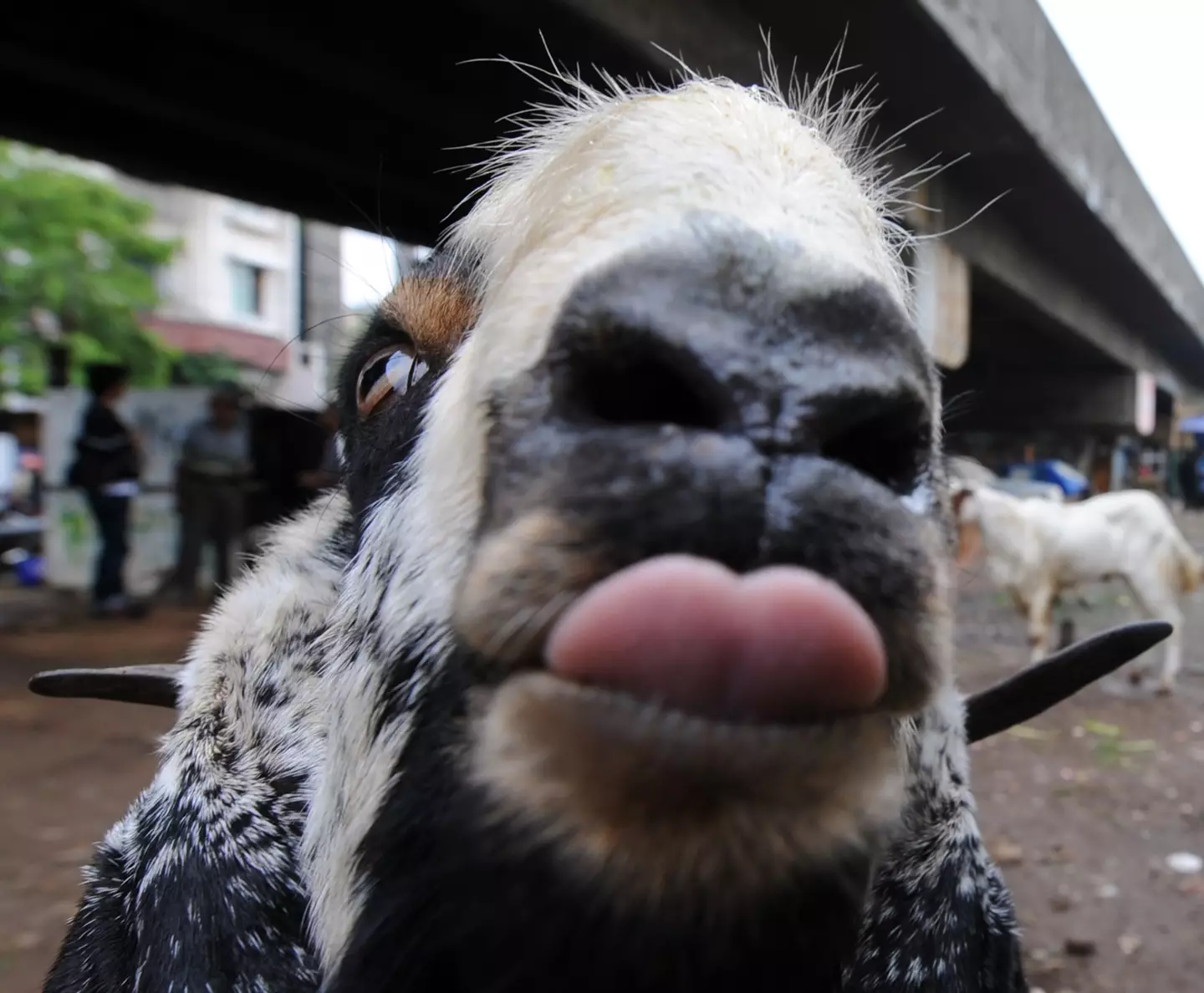Throughout human history, cruelty and ingenuity have often gone hand in hand when it comes to devising torture methods. From elaborate contraptions to disturbingly simple techniques, the creativity applied to inflicting pain knows no bounds. Among these gruesome practices is one of the strangest and most unsettling methods: being “licked to death” by a goat.
While this bizarre-sounding form of torture might seem almost comical at first glance, its reality was anything but. Let’s delve into the chilling history of the “goat’s tongue,” a method that turned an innocent farm animal into an instrument of agony.

The Origins of the ‘Goat’s Tongue’ Torture Method
The “goat’s tongue” torture method is believed to date back to ancient civilizations, including Ancient Rome, where such practices were documented. Unlike elaborate contraptions such as the Iron Maiden or the rack, this method required minimal tools: a bucket of saltwater, a goat, and an unfortunate victim.
This simplicity made it an accessible option for inflicting prolonged suffering. The method was often mentioned in historical accounts condemning the use of torture, highlighting its cruel and inhumane nature.
How the ‘Goat’s Tongue’ Torture Worked
The process started innocuously enough, with the victim’s feet being immersed in saltwater. This not only softened the skin but also made it incredibly salty, enticing the goat to lick the area repeatedly. Once the victim’s feet were thoroughly prepared, they were secured in place, unable to escape the onslaught that was about to begin.
The Goat’s Role in Torture
Goats are naturally attracted to salt, which is why they were ideal participants in this torture. Their rough, abrasive tongues would tirelessly lick the victim’s feet, wearing away the skin layer by layer. Initially, the sensation might have seemed harmless or even ticklish, but as the process continued, it became excruciating.
As the skin eroded, the goat’s persistent licking exposed raw flesh, leaving the victim in unbearable pain. The prolonged exposure to the animal’s tongue and the open wounds it created could lead to severe infections—especially in an era without modern medicine.
The Psychological and Physical Agony
The “goat’s tongue” torture was as much about mental anguish as it was about physical suffering. The anticipation of being subjected to such a slow, degrading, and painful process added a layer of psychological torment.
A Slow Descent into Agony
At first, victims might have dismissed the licking as irritating or even ridiculous. However, as the rough tongue of the goat continued its relentless work, the pain would escalate. The sensitive nerve endings in the feet, combined with the breaking of the skin, turned a seemingly innocent act into a horrifying ordeal.
Risk of Death by Infection
Infection was a constant threat in ancient times, as medical knowledge and hygiene were limited. A goat’s mouth, full of bacteria, licking open wounds created the perfect conditions for severe infections. In many cases, the resulting sepsis or gangrene could lead to death, making the “goat’s tongue” a potentially lethal form of torture.

Oh no, the most terrifying torture implement ever! (ROMEO GACAD/AFP via Getty Images)
Why Was This Method Used?
The “goat’s tongue” torture method was often employed as a form of punishment or interrogation. Its effectiveness lay in its simplicity and its ability to inflict prolonged pain without requiring sophisticated tools.
Symbolism of Humiliation
Beyond the physical pain, this method was designed to humiliate the victim. Being tormented by a farm animal was degrading, reducing the person to a state of vulnerability and powerlessness.
A Torture of Accessibility
Unlike many other methods of torture that required expensive equipment or extensive setup, the “goat’s tongue” method could be implemented almost anywhere. This accessibility made it a favored option in certain societies that lacked the resources for more elaborate punishments.
The Historical Context of Cruelty
The use of animals in torture was not unique to the “goat’s tongue.” Throughout history, animals were often weaponized to inflict pain and fear. Examples include the use of rats, scorpions, and even elephants in gruesome executions.
Roman Era Cruelty
The Ancient Romans, who are believed to have employed this method, were infamous for their brutal punishments. From gladiatorial combat to crucifixion, they used physical pain and public spectacle as tools of control and deterrence. The “goat’s tongue” torture fits into this broader pattern of creative cruelty.
Why the ‘Goat’s Tongue’ Fell Out of Use
As societies evolved and legal systems became more structured, many forms of torture, including the “goat’s tongue,” were abandoned. Public opinion began to shift, viewing such practices as barbaric and inhumane.
The Decline of Torture as Entertainment
In earlier eras, torture was often a public event designed to instill fear or entertain crowds. Over time, cultural and legal reforms pushed for more humane methods of punishment, contributing to the decline of practices like the “goat’s tongue.”
Advancements in Law and Ethics
The development of legal codes that prioritized justice over retribution helped phase out methods like this. The recognition of human rights and the push against cruel and unusual punishment made such practices unacceptable in civilized societies.
A Relic of a Darker Time
The “goat’s tongue” torture serves as a chilling reminder of humanity’s capacity for cruelty. While it may seem absurd to modern sensibilities, it highlights the lengths to which people have gone to inflict pain on others.
A Lesson from History
Reflecting on such practices underscores the importance of empathy, justice, and the need to safeguard human dignity. These relics of the past remind us of the progress we’ve made and the responsibility we have to continue advancing ethical treatment for all.
Conclusion: Grateful for Progress
While the idea of being licked to death by a goat might sound almost laughable at first, the reality of the “goat’s tongue” torture was anything but. This method combined physical pain, psychological torment, and the ever-present threat of infection to create a truly horrifying experience.
Thankfully, such barbaric practices have been consigned to history. Today, as we learn from the mistakes of the past, we can appreciate the progress made in promoting humanity and justice. Let this peculiar and unsettling tale serve as a testament to how far we’ve come—and a reminder to never go back.


